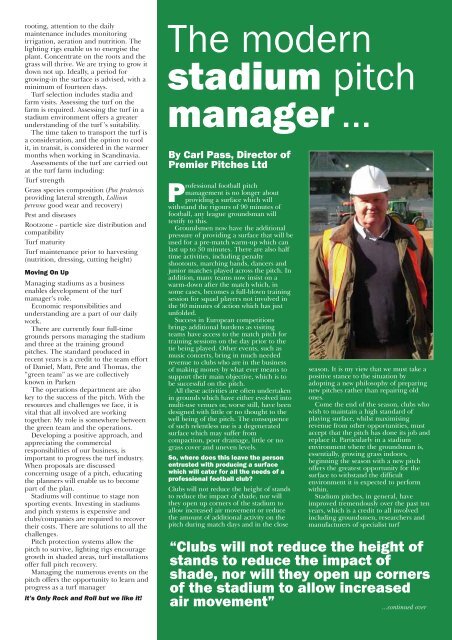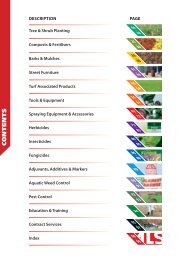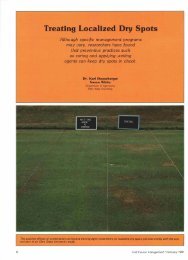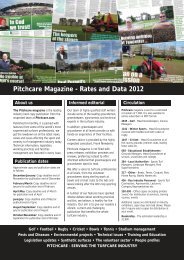Marshalling his troops - Pitchcare
Marshalling his troops - Pitchcare
Marshalling his troops - Pitchcare
You also want an ePaper? Increase the reach of your titles
YUMPU automatically turns print PDFs into web optimized ePapers that Google loves.
ooting, attention to the daily<br />
maintenance includes monitoring<br />
irrigation, aeration and nutrition. The<br />
lighting rigs enable us to energise the<br />
plant. Concentrate on the roots and the<br />
grass will thrive. We are trying to grow it<br />
down not up. Ideally, a period for<br />
growing-in the surface is advised, with a<br />
minimum of fourteen days.<br />
Turf selection includes stadia and<br />
farm visits. Assessing the turf on the<br />
farm is required. Assessing the turf in a<br />
stadium environment offers a greater<br />
understanding of the turf ’s suitability.<br />
The time taken to transport the turf is<br />
a consideration, and the option to cool<br />
it, in transit, is considered in the warmer<br />
months when working in Scandinavia.<br />
Assessments of the turf are carried out<br />
at the turf farm including:<br />
Turf strength<br />
Grass species composition (Poa pratensis<br />
providing lateral strength, Lollium<br />
perenne good wear and recovery)<br />
Pest and diseases<br />
Rootzone - particle size distribution and<br />
compatibility<br />
Turf maturity<br />
Turf maintenance prior to harvesting<br />
(nutrition, dressing, cutting height)<br />
Moving On Up<br />
Managing stadiums as a business<br />
enables development of the turf<br />
manager’s role.<br />
Economic responsibilities and<br />
understanding are a part of our daily<br />
work.<br />
There are currently four full-time<br />
grounds persons managing the stadium<br />
and three at the training ground<br />
pitches. The standard produced in<br />
recent years is a credit to the team effort<br />
of Daniel, Matt, Pete and Thomas, the<br />
“green team” as we are collectively<br />
known in Parken<br />
The operations department are also<br />
key to the success of the pitch. With the<br />
resources and challenges we face, it is<br />
vital that all involved are working<br />
together. My role is somewhere between<br />
the green team and the operations.<br />
Developing a positive approach, and<br />
appreciating the commercial<br />
responsibilities of our business, is<br />
important to progress the turf industry.<br />
When proposals are discussed<br />
concerning usage of a pitch, educating<br />
the planners will enable us to become<br />
part of the plan.<br />
Stadiums will continue to stage non<br />
sporting events. Investing in stadiums<br />
and pitch systems is expensive and<br />
clubs/companies are required to recover<br />
their costs. There are solutions to all the<br />
challenges.<br />
Pitch protection systems allow the<br />
pitch to survive, lighting rigs encourage<br />
growth in shaded areas, turf installations<br />
offer full pitch recovery.<br />
Managing the numerous events on the<br />
pitch offers the opportunity to learn and<br />
progress as a turf manager<br />
It’s Only Rock and Roll but we like it!<br />
The modern<br />
stadium pitch<br />
manager ...<br />
By Carl Pass, Director of<br />
Premier Pitches Ltd<br />
Professional football pitch<br />
management is no longer about<br />
providing a surface which will<br />
withstand the rigours of 90 minutes of<br />
football, any league groundsman will<br />
testify to t<strong>his</strong>.<br />
Groundsmen now have the additional<br />
pressure of providing a surface that will be<br />
used for a pre-match warm-up which can<br />
last up to 30 minutes. There are also half<br />
time activities, including penalty<br />
shootouts, marching bands, dancers and<br />
junior matches played across the pitch. In<br />
addition, many teams now insist on a<br />
warm-down after the match which, in<br />
some cases, becomes a full-blown training<br />
session for squad players not involved in<br />
the 90 minutes of action which has just<br />
unfolded.<br />
Success in European competitions<br />
brings additional burdens as visiting<br />
teams have access to the match pitch for<br />
training sessions on the day prior to the<br />
tie being played. Other events, such as<br />
music concerts, bring in much needed<br />
revenue to clubs who are in the business<br />
of making money by what ever means to<br />
support their main objective, which is to<br />
be successful on the pitch.<br />
All these activities are often undertaken<br />
in grounds which have either evolved into<br />
multi-use venues or, worse still, have been<br />
designed with little or no thought to the<br />
well being of the pitch. The consequence<br />
of such relentless use is a degenerated<br />
surface which may suffer from<br />
compaction, poor drainage, little or no<br />
grass cover and uneven levels.<br />
So, where does t<strong>his</strong> leave the person<br />
entrusted with producing a surface<br />
which will cater for all the needs of a<br />
professional football club?<br />
Clubs will not reduce the height of stands<br />
to reduce the impact of shade, nor will<br />
they open up corners of the stadium to<br />
allow increased air movement or reduce<br />
the amount of additional activity on the<br />
pitch during match days and in the close<br />
season. It is my view that we must take a<br />
positive stance to the situation by<br />
adopting a new philosophy of preparing<br />
new pitches rather than repairing old<br />
ones.<br />
Come the end of the season, clubs who<br />
wish to maintain a high standard of<br />
playing surface, whilst maximising<br />
revenue from other opportunities, must<br />
accept that the pitch has done its job and<br />
replace it. Particularly in a stadium<br />
environment where the groundsman is,<br />
essentially, growing grass indoors,<br />
beginning the season with a new pitch<br />
offers the greatest opportunity for the<br />
surface to withstand the difficult<br />
environment it is expected to perform<br />
within.<br />
Stadium pitches, in general, have<br />
improved tremendously over the past ten<br />
years, which is a credit to all involved<br />
including groundsmen, researchers and<br />
manufacturers of specialist turf<br />
“Clubs will not reduce the height of<br />
stands to reduce the impact of<br />
shade, nor will they open up corners<br />
of the stadium to allow increased<br />
air movement” ...continued over

















